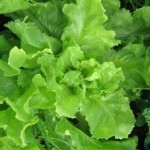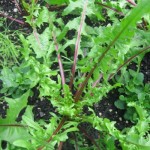Endives & Chicories
Chicories and endives are among the Italians’ favourite vegetables – they have been around for centuries and still cannot be surpassed for goodness.
They are classed as a ‘bitter’ vegetable, which are types that we need to eat to keep healthy, along with the sweeter vegetables, and contain lots of vitamins and minerals. Do not be put off by the term ‘bitter’; they all taste slightly peppery but when these vegetables are eaten with a mixture of others they all taste great and there is no bitterness as we know it. The younger the leaves are more tender and milder they are. Chicories and endives produce extremely well, with some of the leafy types growing to 50cm diameter.

Escarole
My favourite endive is the Escarole type. This one is non-hearting, sweeter and has larger flat pale green leaves. It makes a great show in the garden as well as being a great ingredient for winter salads and sandwiches. It pairs very well with eggs so try an egg sandwich with escarole added-yum!
The frilly leafy endives are very decorative in the garden, coming in various shades of greens, yellow and cream. White endive looks beautiful in the garden with its delicate, lemony white frilly leaves, while the fine cut type graduates from green to lime green to creamy/yellow centres. The broader leaved green type is the oldest, dating back to the 17th. Century, and the strongest, but very flavoursome when used with other winter salad ingredients.

Leafy Radicchio
Radicchio is another vegetable classed as one of the old Italian ‘bitter’ vegetables. There are two main types of the chicory known as radicchio-the low growing Palla Rossa or Chioggia type is great for several reasons: while growing it looks bright and cheerful, with its iridescent magenta leaves; to me it resembles red roses when used as a border in both the vegetable garden and flower garden! It self blanches while growing and when you cut into it you find the white ribs which with the bright red leaves makes a very tasty colourful vegetable.
The other type, sometimes known as Red Treviso, is leafier, and slightly sweeter- when planted in rows it also makes a great border, this one resembling small waterlilies! Mix both types with other winter vegetables to make delicious winter salads, and as the flavour is even better when radicchio is slightly cooked, try halving the Palla Rossa type and slow cooking it or try both types in stirfries, etc. with olives, apples or walnuts!
Radicchio is easy to grow and is also a snail and slug deterrent- they do not like the red pigment in this plant.

Asparagus chicory, red stemmed
Asparagus chicory looks like dandelion- in fact it is called “Italian dandelion greens’ in some countries. The red stemmed version is very attractive and brightens up your winter garden., giving an extra dimension with its upright growth.
It is easy to pick, being upright, and has similar flavour to the other chicories, slightly peppery. Use raw in salads, mixed with other greens, and stirfry or sauté.
The other member of the chicory family that European people are very fond of is Whitloof. This is grown in the dark, so chlorophyll is prevented from developing, which keeps the leaves white. It is used the same way as other chicories, but has a more delicate flavour, so be careful not to overpower it. Use in winter salads or chop in half and cook slowly over low heat.

